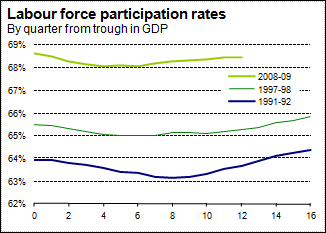There’s still time for job seekers to become disillusioned
One of the curious outcomes in the aftermath of the 2008/09 recession is that the “discouraged worker effect” has been muted. Traditionally as unemployment rises during an economic slowdown, people who have previously been looking for work get tired of the lack of job opportunities and drop out of the labour force. To be counted as part of the official labour force, people must be either working, or available and actively looking for work in the last four weeks, or have a job to start in the next four weeks.
At first glance, our graph suggests that the labour market differences between the recent recession and the two downturns in the 1990s are not that large. Across all three events, the participation rate, or proportion of working-age people in the labour force, fell by between 0.6 and 0.8 percentage points in the two years after the recession hit. However, there are two reasons we might have expected the participation rate to have fallen further this time around.

Firstly, participation in the labour force is substantially higher now than during the 1990s. This lift in participation is concentrated in men aged 55 and over, and women aged between 25 and 39 and over 50. Improving health outcomes, a higher retirement age, decisions to have children later in life, and an increased incidence of working mothers have all been factors in these outcomes. But there was also a suspicion prior to the global financial crisis that the very tight job market was drawing an unusually and possibly unsustainably high number of people into the labour force – people that would drift out of the labour force again when the market turned down. So far, that reversal hasn’t really occurred.
Secondly, the recent economic downturn has been more severe than either of its 1990s counterparts. Economic activity in the March quarter was up just 1.6% from its pre-recession peak. At the same stage, almost three years, after each of the 1990s recessions, the economy was 7-8% larger than before the downturn. The fact that the economy has been sluggish for so long this time around should have seriously undermined people’s enthusiasm to keep looking for work.
If we look at the types of people where the declines in labour force participation have been small, it’s been for men aged 30-49 and women aged 35-39. This range includes people settling down and buying their first house, people with young children, and people with older children moving towards their peak earning years.
So what’s caused the difference this time around? The government’s introduction of Working for Families between 2005 and 2007 significantly increased the incentive for lower-income people with dependent children to be working a minimum number of hours per week. The In-work Tax Credit effectively increased the income gap between working and welfare benefits, providing an extra incentive for people with children to keep up the search for work, even when the going gets tough.
Household debt levels are also a possible factor behind people’s willingness to keep looking for work. Reserve Bank data shows that household debt, as a percentage of disposable income, surged from 96% to 153% over the decade to 2008. Faced with owing so much money, households may have been desperate for work to keep the debt collectors at bay. The types of people identified above will typically have a mortgage and, if they were relatively recent entrants into the housing market, that mortgage could be large relative to their income.
An uneven pick-up in demand for workers across different segments of the labour market also suggests that job opportunities are more plentiful for some workers than for others. Labour market conditions for plant and machine operators, for example, are better than in previous downturns, making these types of workers less likely to drop out of the labour force. In contrast, opportunities for sales workers are few and far between, with the unemployment rate for these workers now over 12%.
There have recently been anecdotes of skill shortages starting to become an issue for employers again, which would be good news for workers. But looking closely at the NZIER’s survey results, it becomes clear that these apparent skill shortages are not developing as quickly as they did following the 1990s recessions. This outcome makes sense given the sluggish recovery in economic growth to date.
In general, the economy still has plenty of spare capacity and, given current growth prospects, that capacity will take a while to be used up. We expect the unemployment rate to hold above 6% for another two years yet, so there’s still plenty of time for workers to become disillusioned and give up the search for a job.

















